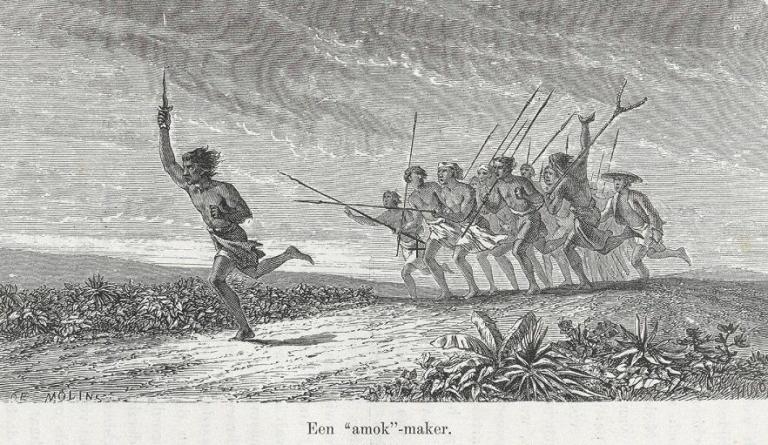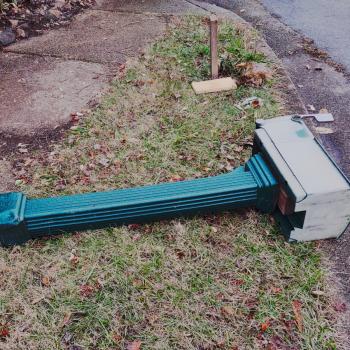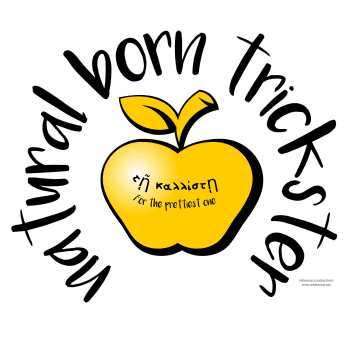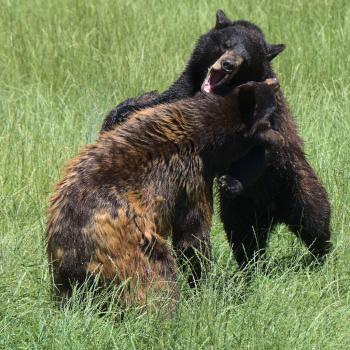The word “amok” has a humorous connotation in the US — going back at least to the classic 1953 Chuck Jones cartoon “Duck Amuck”. We might describe ourselves going off a diet and eating too many sweets, or a hoard of rampaging preschoolers, as “running amok”.
But originally “amok” referred to a form of mass murder. It derives from the Malay word mengamok, meaning “to make a furious and desperate charge”, and originally meant a sudden attack where someone would maim and kill their fellow villagers (and sometimes animals). Centuries ago among the Malay, a typical amok attack might claim ten victims; frequently the attacker would not relent and would be killed in the process of stopping the attack.
Captain Cook was the first Westerner to observe and record this phenomenon, in 1770. Subsequently, similar behavior was seen in the Philippines, Laos, Papua New Guinea, and Puerto Rico. Anthropologists believed that the phenomenon was unique to these “primitive” (so-called) cultures.
The Malay believed that the attacks were the result of spirit possession. (It’s noteworthy that Gerald Gardner spent years in British Malaya; as I describe in Why Buddha Touched the Earth, it’s likely that the religious practices he saw there influenced his later ideas about Wicca.[Swiss]) As these cultures Westernized and industrialized, reports of amok decreased, and pretty much ceased around the mid-20th century.

Western psychiatry has considered amok a “culture-bound syndrome”, something caused by unique cultural factors.[Saint Martin] (This notion of culture-bound psychiatric syndromes brings up Thomas Szasz’s observation that all diagnosis of so-called “mental illness” involves “comparison or matching of the patient’s ideas, concepts, or beliefs with those of the observer and the society in which they live,” rather than any objective standard;[Szasz] but that’s a tangential rant.)
Amok in the Contemporary West
But the behavior of someone amok sounds familiar to any Westerner watching the news. Particularly so in the U.S., but (contrary to popular belief) spree killings occur in some other countries at a roughly comparable rate.[Herring and Jacobson] There seems to be a growing willingness to recognize that these modern mass killings share the same nature as the amok attacks observed centuries ago. Forensic psychiatrist Manuel Saint Martin notes:
Contemporary descriptions of multiple homicides by individuals are comparable to the case reports of amok. In the majority of contemporary cases, the slayings are sudden and unprovoked and committed by individuals with a history of mental illness. News media, witnesses, and police reports describe the attackers as being odd or angry persons, suggesting personality pathology or a paranoid disorder; or brooding and suffering from an acute loss, indicating a possible depressive disorder. The number of victims in modern episodes is similar to the number in amok despite the fact that handguns and rifles are used in contrast to the Malay swords of 2 centuries ago. The outcome for the attacker is also analogous to amok, being death, suicide, and less commonly, apprehension.[Saint Martin]
A 1993 German study identified almost two hundred incidents of amok in industrialized countries over the preceding decade. The results are interesting because this study is both pre-Columbine and not centered on the United States.
It found that amok attacks fell into two distinct groups, attacks on family and attacks on strangers.
Attacks on family had older perpetrators, who were less likely to have an identifiable mental health condition, who seldom left any victims alive, and who almost always committed suicide afterwards. (This may create a selection bias in terms of identifying mental health conditions.)
Attacks on strangers were committed by younger attackers, who could be identified as passive-aggressive, psychopathic, paranoid, or intoxicated. These attackers killed about half of their victims but injured many more, and rarely committed suicide.[Adler, 1993]
(It may be that the example of Columbine, which has since inspired several of the more notorious and deadly school shooters, has changed the prevalence of suicide among those attacking strangers.)
A later study by the same lead researcher found that the prevalence of amok in Germany decreased slightly in the 1990s versus the 1980s, though the use of weapons, especially firearms, increased. [Adler, 2006]
(There is a third category of mass killings: those committed as part of some “ordinary” criminal activity or arising from a more commonplace sort of dispute. These attacks have a more readily understood motive and don’t fit the amok model, so we won’t discuss them further here, but they are important to the broader topic of violent crime. They are about as frequent as familicides and roughly twice as frequent as mass attacks on strangers.[Krouse, 2])
We have here a phenomenon which is not exclusive to America or to the West, nor to the modern day. It was not unknown in the U.S. before the 20th century — an 1863 ax attack in the Nevada territory was even described by a contemporary newspaper as “A Maniac Runs A Muck”[“Frightful occurrence”] — but even as it decreased in the culture in which it was originally described, it seems to have become more common here in the past few decades.
The Frequency of Amok Attacks
But our population has also increased. Have these incidents actually become more common per capita, or is it just that we have more people around and so we have more of every type of human phenomena?
Public mass shootings get most of the attention of the press and so are easier to track over time than other forms of attack. Criminologist Grant Duwe put together a count going back to 1900, using data from the FBI and news reports.[Kessler; Duwe, “The Truth”; Selby]
Using his counts[Duwe, “Mass Public Shootings”], plus census data on population, we can estimate the decade-by-decade public mass shooting rate over the 20th and early 21st century:
1900s: 4.75 / 100,000,000
1910s: 4.04
1920s: 0.87
1930s: 7.05
1940s: 6.35
1950s: 0.60
1960s: 3.66
1970s: 6.51
1980s: 12.6
1990s: 14.3
2000s: 11.9
2010s (2010-2014): 12.7
(See the appendix for details. Other researchers have used different definitions and criteria, but this illustrates the trend.)
So we see that the rate of mass public shootings has varied enormously; that they are not an invention of the late 20th century; that like the overall homicide rate, the public mass shooting rate peaked in the 1990s and then started to fall. (And we also see how rare these events are, that over a decade just ten or fifteen people out of one hundred million may commit such a shooting.)
To attempt to compare the first half of this decade, I’ve taken the count for 2010 to 2014 and doubled it; that shows an increase over the 2000s, but that’s due to a spike in 2012, with seven such incidents; 2013 saw only three, 2014 two, and 2015 four[Duwe, “Mass Public Shootings”]. So there does not seem to be an upward trend year to year.
Duwe’s research found that mass murder overall — not just its public manifestation — was about as common during the 1920s and early 1930s as in the 2000s. The rate dropped in the 1940s and 50s (not counting the organized mass murder of WWII and Korea) before starting to rise again in the 1960s. But the typical amok mass murder during the Depression and the Dust Bowl was less likely to be a public attack, and more likely to be a failed farmer, no longer able to provide for his family and killing them before committing suicide.[Crenson]
Focus on People, Not On Things
Firearms — even semi-automatic firearms, a 19th century invention — have been readily available in the U.S. for a long time. But the rates of homicide in general, and amok mass attacks in particular, have fluctuated widely. So the legal availability of firearms cannot be a primary driver of either homicide in general, or of mass murder.
The fault, dear Americans, is not in our guns, but in ourselves, that we are brutal and careless about each other; that we live in a nation where racism and economic injustice and a culture of violent domination can set someone on the path to murder, and poor access to mental health care and a broken criminal justice system makes it unlikely that they will be stopped before they explode.
At best, approaches based on weapons — either better arming defenders, or trying to make it a bit more difficult for attackers to get certain types of guns — can only make marginal changes in the casualty counts in amok attacks.
And these approaches have significant costs.
Trying to protect our schools with armed police, armed private guards, or armed teachers can intimidate students. And there is concern that police in schools have led to school discipline issues becoming criminal matters, with students (especially minority students) being arrested and being fed into a “school to prison pipeline”.[Brown] Some worry about armed teachers escalating student discipline problems in a similar fashion.
I’m not saying that armed defense of schools can’t be done in a way that’s helpful, but it does have its hazards and costs.
As for more gun prohibitions, purchasing or possessing a taboo firearm is not an act that has a victim to file a complaint. Like all laws against consensual crimes, gun bans can only be enforced with invasive measures. One does not have to be a “gun nut” to see the inherent civil liberties problems in a “war on guns”, any more than one has to be a drug user to see the problems with a “war on drugs”.
Our existing gun prohibitions disproportionately lock up people from racial and ethnic minorities[Balko] and are enforced with measures like entrapping a man with an IQ of 50 to work at an ATF front.[Cooke] In the extreme, gun law enforcement looks like the paramilitary sieges at Ruby Ridge and Waco.
It’s a value judgment, but I find that forcing people who have not threatened anyone into a cage because they don’t have the right documents for a firearm, and the violent raids it takes to locate such transgressions, to be a high cost.
And I repeat: such laws could at best only make marginal changes in the casualty counts in amok attacks. If Goddess herself came down and made all semiautomatic firearms stop working, history shows that attackers with shotguns and bolt-action rifles[Armstrong] or with revolvers[Swaine] — or, in cultures where murdering people with guns is considered beyond the pale, pickaxes[Sephton] or machetes[“22 Guests”] — can rack up body counts in the double digits.
(As we quoted Saint Martin observing above, the casualties of today’s attacks with firearms are not very different from those of amok Malays armed with swords centuries ago.
To solve the problem of amok we must turn our attention not to the inanimate objects involved but to the people, and to the cultural, psychological, and spiritual factors behind these incidents.
We don’t have to believe in literal spirit possession, as the Malay of Captain Cook’s time did, to see that there are spiritual matters at work here.
Amok attacks represent a failure of meaning and connection in someone’s life, a fracturing of their relationship with themselves, their community, and the universe. While history shows that this fracturing can occur even in tribal cultures, these sort of relationships are especially corroded by industrial capitalist society; and that corrosion has gotten worse in recent decades with the rise of neoliberalism, which views human beings as atomized, disconnected individuals.[Hari]
And here we get to the spiritual matters involved. For both the Neopagan movement and the Western interest in Eastern religions emerged as a response to the destructive effects that the Industrial Revolution and the rise of capitalism had on these relationships.
From the Romantics through the Transcendentalists to the Theosophists to the Golden Dawn to Garnerian Wicca, and also including the Beats and the Woodcraft movement and the 1960s counterculture,[Swiss] poets and Pagans and magicians and naturalists and Western yogis and Zennists have been looking for ways to reconnect, to re-tie — “re ligere”, the Latin root of our word “religion” — us to the world.
I put it to you that the solutions to this violence lie in meditation and in magic and in mysticism, in re-enchantment and re-wilding, in gathering together in celebration and in reverence, in living here and now with each other rather than thinking that owning more things later, or having more power later, or having more fame (or criminal infamy) later, will bring us satisfaction.
If you’ll forgive the conceit, I might suggest that the answer to “amok” lies at the other end of the alphabet: in “Zen Paganism”.
References
“22 Guests Slain.” The Bend Bulletin. 21 Apr 1950. p 6. https://news.google.com/newspapers?id=529YAAAAIBAJ&sjid=EPgDAAAAIBAJ&pg=1389,1304611&dq=
Adler L, Lehmann K, Räder K, Schünemann KF. “‘Running amok’ — content analytic study of 196 news presentations from industrialized countries.” Fortschritte der Neurologie-Psychiatrie. 1993 Dec; 61(12):424-33. https://www.ncbi.nlm.nih.gov/pubmed/8112706
Adler L, Marx D, Apel H, Wolfersdorf M, Hajak G. “Stability of the ‘amok runner syndrome'”. Fortschritte der Neurologie-Psychiatrie. 2006 Oct (Epub 2006 Jan 2); 74(10):582-90. https://www.ncbi.nlm.nih.gov/pubmed/16586259
Armstrong, Jeremy. “Crazed cabbie Derrick Bird asked stranger ‘Are you having a nice day?’ then shot her in face”. Mirror Online. 2 Mar 2011 (updated 26 Jan 2012). https://www.mirror.co.uk/news/uk-news/crazed-cabbie-derrick-bird-asked-113713
Balko, Radley. “Shaneen Allen, race and gun control”. Washington Post: The Watch. 22 Jul 2014. https://www.washingtonpost.com/news/the-watch/wp/2014/07/22/shaneen-allen-race-and-gun-control/
Brown, Emma. “Police in schools: Keeping kids safe, or arresting them for no good reason?”. Washington Post. 8 Nov 2015. https://www.washingtonpost.com/local/education/police-in-schools-keeping-kids-safe-or-arresting-them-for-no-good-reason/2015/11/08/937ddfd0-816c-11e5-9afb-0c971f713d0c_story.html
Cooke, Charles C. W. “How the ATF Manufactures Crime.” National Review 10 Dec 2013. https://www.nationalreview.com/2013/12/how-atf-manufactures-crime-charles-c-w-cooke/
Crenson, Matt. “Mass Shootings More Common Since 1960s.” Washington Post (Associated Press), 21 April 2007. http://www.washingtonpost.com/wp-dyn/content/article/2007/04/21/AR2007042100609.html
Duwe, Grant. “Mass Public Shootings in the United States, 1900-2016.” 2016 https://docs.google.com/spreadsheets/d/1l_dpvfkiTzZjlW_Ll4VRpkd9BgAMqImaHFmmpwGE5v4/edit#gid=1133280616
Duwe, Grant. “The Truth About Mass Public Shootings.” Reason. 28 Oct 2014 http://reason.com/archives/2014/10/28/the-truth-about-mass-public-shootings
“Frightful occurrence – A maniac runs a muck.” The Daily True Delta. 17 Sep 1863. https://news.google.com/newspapers?id=Fu0zAAAAIBAJ&sjid=mjgHAAAAIBAJ&pg=6856,24827
Hari, Johann. “Is Neoliberalism Making Our Depression and Anxiety Crisis Worse?” In These Times 21 Feb 2018. http://inthesetimes.com/article/20930/depressed-anxious-blame-neoliberalism/
Herring, Keely and Louis Jacobson. “Is Barack Obama correct that mass killings don’t happen in other countries?” Politifact. 22 Jun 2015. http://www.politifact.com/truth-o-meter/statements/2015/jun/22/barack-obama/barack-obama-correct-mass-killings-dont-happen-oth/
Kessler, Glenn. “Bill Clinton’s over-the-top ‘fact’ on mass shootings.” Washington Post: The Fact Checker. 11 Jan 11, 2013. https://www.washingtonpost.com/blogs/fact-checker/post/bill-clintons-over-the-top-fact-on-mass-shootings/2013/01/10/7040d61e-5b7a-11e2-9fa9-5fbdc9530eb9_blog.html
Krouse, William J and Daniel J. Richardson. Mass Murder with Firearms: Incidents and Victims, 1999-2013. Congressional Research Service, 30 Jul 2015. https://fas.org/sgp/crs/misc/R44126.pdf
Saint Martin, Manuel L. “Running Amok: A Modern Perspective on a Culture-Bound Syndrome.” Primary Care Companion to The Journal of Clinical Psychiatry. 1999 Jun; 1(3): 66–70. https://www.ncbi.nlm.nih.gov/pmc/articles/PMC181064/
Selby, W. Gardner. “Steve Adler wrong that first U.S. ‘mass shooting’ occurred in Austin.”Politifat Texas. 23 Jun 2016. http://www.politifact.com/texas/statements/2016/jun/23/steve-adler/steve-adler-wrong-first-us-mass-shooting-occurred-/
Sephton, Connor. “Man who killed parents and then 17 neighbours to cover it up given death penalty in China.” Sky News. 28 Jul 2017. https://news.sky.com/story/man-who-killed-parents-and-then-17-neighbours-to-cover-it-up-given-death-penalty-in-china-10964998
Swaine, Jon. “Brazil school shooting: at least 12 children killed in Rio as former pupil goes on rampage.” The Telegraph. 7 Apr 2011. https://www.telegraph.co.uk/news/worldnews/southamerica/brazil/8435921/Brazil-school-shooting-at-least-12-children-killed-in-Rio-as-former-pupil-goes-on-rampage.html
Swiss, Tom. Why Buddha Touched the Earth: Zen Paganism for the 21st Century. Stafford: Megalithica Books, 2013. p 62-95, 114-139. http://infamous.net/WhyBuddhaTouchedTheEarth/
Szasz, Thomas S. “The Myth of Mental Illness.” American Psychologist, 1960, 15, 113-118. http://psychclassics.yorku.ca/Szasz/myth.htm/b
Appendix
Estimating mass shooting rates per decade.
I. Population Decennial census: 1900: 76,212,168 1910: 92,228,496 1920: 106,021,537 1930: 123,202,624 1940: 132,164,569 1950: 151,325,798 1960: 179,323,175 1970: 203,302,031 1980: 226,542,199 1990: 248,709,873 [https://www.census.gov/population/censusdata/table-16.pdf] 2000: 281,421,906 [https://www.census.gov/history/www/through_the_decades/fast_facts/2000_new.html] 2010: 308,745,538 [https://www.census.gov/history/www/through_the_decades/fast_facts/2010_fast_facts.html] 2014 estimated population: 318,907,401 [https://factfinder.census.gov/bkmk/table/1.0/en/PEP/2015/PEPAGESEX] Mean population per decade, based on simple linear interpolation: 1900s: 84220332.0 1910s: 99125016.5 1920s: 114612080.5 1930s: 127683596.5 1940s: 141745183.5 1950s: 165324486.5 1960s: 191312603.0 1970s: 214922115.0 1980s: 237626036.0 1990s: 265065889.5 2000s: 295083722.0 2010-2014: 313826469.5 II. Public mass shooting counts From Duwe, "Mass Public Shootings in the United States, 1900-2016." 1900s 4 1910s 4 1920s 1 1930s 9 1940s 9 1950s 1 1960s 7 1970s 14 1980s 30 1990s 38 2000s 35 2010-2014 40 (20 incidents, doubled for comparison)













